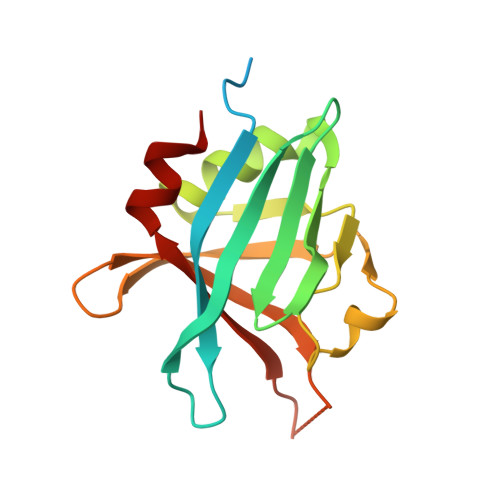Crystal Structures of the Erp Protein Family Members Erpp and Erpc from Borrelia Burgdorferi Reveal the Reason for Different Affinities for Complement Regulator Factor H.
Brangulis, K., Petrovskis, I., Kazaks, A., Akopjana, I., Tars, K.(2015) Biochim Biophys Acta 1854: 349
- PubMed: 25582082
- DOI: https://doi.org/10.1016/j.bbapap.2014.12.025
- Primary Citation of Related Structures:
4BOB, 4BOD, 4BXM - PubMed Abstract:
Borrelia burgdorferi is the causative agent of Lyme disease, which can be acquired after the bite of an infected Ixodes tick. As a strategy to resist the innate immunity and to successfully spread and proliferate, B. burgdorferi expresses a set of outer membrane proteins that are capable of binding complement regulator factor H (CFH), factor H-like protein 1 (CFHL-1) and factor H-related proteins (CFHR) to avoid complement-mediated killing. B. burgdorferi B31 contains three proteins that belong to the Erp (OspE/F-related) protein family and are capable of binding CFH and some CFHRs, namely ErpA, ErpC and ErpP. We have determined the crystal structure of ErpP at 2.53Å resolution and the crystal structure of ErpC at 2.15Å resolution. Recently, the crystal structure of the Erp family member OspE from B. burgdorferi N40 was determined in complex with CFH domains 19-20, revealing the residues involved in the complex formation. Despite the high sequence conservation between ErpA, ErpC, ErpP and the homologous protein OspE (78-80%), the affinity for CFH and CFHRs differs markedly among the Erp family members, suggesting that ErpC may bind only CFHRs but not CFH. A comparison of the binding site in OspE with those of ErpC and ErpP revealed that the extended loop region, which is only observed in the potential binding site of ErpC, plays an important role by preventing the binding of CFH. These results can explain the inability of ErpC to bind CFH, whereas ErpP and ErpA still possess the ability to bind CFH.
Organizational Affiliation:
Latvian Institute of Organic Synthesis, Aizkraukles 21, LV-1006 Riga, Latvia; Latvian Biomedical Research and Study Centre, Ratsupites 1, LV-1067 Riga, Latvia; Riga Stradins University, Dzirciema 16, LV-1007 Riga, Latvia. Electronic address: kalvis@biomed.lu.lv.














